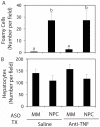Evaluation of an anti-tumor necrosis factor therapeutic in a mouse model of Niemann-Pick C liver disease
- PMID: 20886067
- PMCID: PMC2944848
- DOI: 10.1371/journal.pone.0012941
Evaluation of an anti-tumor necrosis factor therapeutic in a mouse model of Niemann-Pick C liver disease
Abstract
Background: Niemann-Pick type C (NPC) disease is a lysosomal storage disease characterized by the accumulation of cholesterol and glycosphingolipids. The majority of NPC patients die in their teen years due to progressive neurodegeneration; however, half of NPC patients also suffer from cholestasis, prolonged jaundice, and hepatosplenomegaly. We previously showed that a key mediator of NPC liver disease is tumor necrosis factor (TNF) α, which is involved in both proinflammatory and apoptotic signaling cascades. In this study, we tested the hypothesis that blocking TNF action with an anti-TNF monoclonal antibody (CNTO5048) will slow the progression of NPC liver disease.
Methodology/principal findings: Treatment of wild-type C57BL/6 mice with NPC1-specific antisense oligonucleotides led to knockdown of NPC1 protein expression in the liver. This caused classical symptoms of NPC liver disease, including hepatic cholesterol accumulation, hepatomegaly, elevated serum liver enzymes, and lipid laden macrophage accumulation. In addition, there was a significant increase in the number of apoptotic cells and a proliferation of stellate cells. Concurrent treatment of NPC1 knockdown mice with anti-TNF had no effect on the primary lipid storage or accumulation of lipid-laden macrophages. However, anti-TNF treatment slightly blunted the increase in hepatic apoptosis and stellate cell activation that was seen with NPC1 knockdown.
Conclusions/significance: Current therapeutic options for NPC disease are limited. Our results provide proof of principle that pharmacologically blocking the TNF-α inflammatory cascade can slightly reduce certain markers of NPC disease. Small molecule inhibitors of TNF that penetrate tissues and cross the blood-brain barrier may prove even more beneficial.
Conflict of interest statement
Figures





Similar articles
-
In vivo antisense oligonucleotide reduction of NPC1 expression as a novel mouse model for Niemann Pick type C- associated liver disease.Hepatology. 2008 May;47(5):1504-12. doi: 10.1002/hep.22327. Hepatology. 2008. PMID: 18438776 Free PMC article.
-
TNF-{alpha} plays a role in hepatocyte apoptosis in Niemann-Pick type C liver disease.J Lipid Res. 2009 Feb;50(2):327-33. doi: 10.1194/jlr.M800415-JLR200. Epub 2008 Sep 24. J Lipid Res. 2009. PMID: 18815434 Free PMC article.
-
Normalization of Hepatic Homeostasis in the Npc1nmf164 Mouse Model of Niemann-Pick Type C Disease Treated with the Histone Deacetylase Inhibitor Vorinostat.J Biol Chem. 2017 Mar 17;292(11):4395-4410. doi: 10.1074/jbc.M116.770578. Epub 2016 Dec 28. J Biol Chem. 2017. PMID: 28031458 Free PMC article.
-
The potential of histone deacetylase inhibitors in Niemann - Pick type C disease.FEBS J. 2013 Dec;280(24):6367-72. doi: 10.1111/febs.12505. Epub 2013 Sep 23. FEBS J. 2013. PMID: 23992240 Free PMC article. Review.
-
Endo-lysosomal dysfunction and neuronal-glial crosstalk in Niemann-Pick type C disease.Philos Trans R Soc Lond B Biol Sci. 2024 Apr 8;379(1899):20220388. doi: 10.1098/rstb.2022.0388. Epub 2024 Feb 19. Philos Trans R Soc Lond B Biol Sci. 2024. PMID: 38368932 Free PMC article. Review.
Cited by
-
Macrophage-derived tumor necrosis factor-α mediates diabetic renal injury.Kidney Int. 2015 Oct;88(4):722-33. doi: 10.1038/ki.2015.162. Epub 2015 Jun 10. Kidney Int. 2015. PMID: 26061548 Free PMC article.
-
Gadolinium Chloride Rescues Niemann⁻Pick Type C Liver Damage.Int J Mol Sci. 2018 Nov 14;19(11):3599. doi: 10.3390/ijms19113599. Int J Mol Sci. 2018. PMID: 30441844 Free PMC article.
-
Serum miRNA signature diagnoses and discriminates murine colitis subtypes and predicts ulcerative colitis in humans.Sci Rep. 2017 May 31;7(1):2520. doi: 10.1038/s41598-017-02782-1. Sci Rep. 2017. PMID: 28566745 Free PMC article.
-
Complement Component C3 Participates in Early Stages of Niemann-Pick C Mouse Liver Damage.Int J Mol Sci. 2020 Mar 20;21(6):2127. doi: 10.3390/ijms21062127. Int J Mol Sci. 2020. PMID: 32244854 Free PMC article.
-
Deficiency of myeloid NPC1 exacerbates liver injury and fibrosis by impairing macrophage efferocytosis.J Adv Res. 2025 Jun;72:213-227. doi: 10.1016/j.jare.2024.11.020. Epub 2024 Nov 14. J Adv Res. 2025. PMID: 39547438 Free PMC article.
References
-
- Vanier MT, Millat G. Niemann-Pick disease type C. Clin Genet. 2003;64:269–281. - PubMed
-
- Patterson MC, Vanier MT, Suzuki K, Morris JA, Carstea E, et al. Niemann-Pick Disease Type C: A Lipid Trafficking Disorder. In: Scriver CR, Beaudet AL, Sly WS, Valle D, editors. The Metabolic and Molecular Bases of Inherited Disease. 8th ed. New York: McGraw-Hill; 2001. pp. 3611–3633.
-
- Garver WS, Francis GA, Jelinek D, Shepherd G, Flynn J, et al. The National Niemann-Pick C1 disease database: report of clinical features and health problems. Am J Med Genet A. 2007;143:1204–1211. - PubMed
-
- Kelly DA, Portmann B, Mowat AP, Sherlock S, Lake BD. Niemann-Pick disease type C: diagnosis and outcome in children, with particular reference to liver disease. J Pediatr. 1993;123:242–247. - PubMed
-
- Yerushalmi B, Sokol RJ, Narkewicz MR, Smith D, Ashmead JW, et al. Niemann-pick disease type C in neonatal cholestasis at a North American Center. J Pediatr Gastroenterol Nutr. 2002;35:44–50. - PubMed
Publication types
MeSH terms
Substances
Grants and funding
LinkOut - more resources
Full Text Sources
Other Literature Sources
Medical

